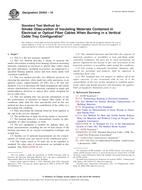Potřebujeme váš souhlas k využití jednotlivých dat, aby se vám mimo jiné mohly ukazovat informace týkající se vašich zájmů. Souhlas udělíte kliknutím na tlačítko „OK“.
ASTM D5424-10
Standard Test Method for Smoke Obscuration of Insulating Materials Contained in Electrical or Optical Fiber Cables When Burning in a Vertical Cable Tray Configuration
Automaticky přeložený název:
Standardní zkušební metoda pro zacloněním kouřem z izolačních materiálů obsažených v elektrických a optických kabelů při vypalování ve svislé Cable konfigurace zásobníku
NORMA vydána dne 1.3.2010
Informace o normě:
Označení normy: ASTM D5424-10
Poznámka: NEPLATNÁ
Datum vydání normy: 1.3.2010
Kód zboží: NS-31121
Počet stran: 20
Přibližná hmotnost: 60 g (0.13 liber)
Země: Americká technická norma
Kategorie: Technické normy ASTM
Anotace textu normy ASTM D5424-10 :
Keywords:
cable, cable tray, carbon dioxide, carbon monoxide, char, electrical cable, fire, fire-test response, flame, heat release, heat release rate, ignition, optical density, optical fiber cable, oxygen consumption calorimetry, smoke obscuration, smoke release, smoke release rate, total smoke released, toxic gases, Burning cables, Cables, Calorimeter, Carbon dioxide, Carbon monoxide (CO), Electrical shielding cable, Exhaust system design, Fire testing--electrical insulating materials
Doplňující informace
| Significance and Use | ||||||||||||||||
|
This test method provides a means to measure a variety of fire-test-response characteristics associated with smoke obscuration and resulting from burning the electrical insulating materials contained in electrical or optical fiber cables. The specimens are allowed to burn freely under well ventilated conditions after ignition by means of a propane gas burner. Smoke obscuration quantifies the visibility in fires. This test method is also suitable for measuring the rate of heat release as an optional measurement. The rate of heat release often serves as an indication of the intensity of the fire generated. Other optional fire-test-response characteristics that are measurable by this test method are useful to make decisions on fire safety. The most important gaseous components of smoke are the carbon oxides, present in all fires. They are major indicators of the toxicity of the atmosphere and of the completeness of combustion and are often used as part of fire hazard assessment calculations and to improve the accuracy of heat release measurements. Other toxic gases, which are specific to certain materials, are less crucial for determining combustion completeness. Test Limitations: The fire-test-response characteristics measured in this test method are a representation of the manner in which the specimens tested behave under certain specific conditions. Do not assume they are representative of a generic fire performance of the materials tested when made into cables of the construction under consideration. In particular, it is unlikely that this test method is an adequate representation of the fire behavior of cables in confined spaces, without abundant circulation of air. This is an intermediate-scale test, and the predictability of its results to large scale fires has not been determined. Some information exists to suggest that it has been validated against some large-scale scenarios. |
||||||||||||||||
| 1. Scope | ||||||||||||||||
|
1.1 This is a fire-test-response standard. 1.2 This test method provides a means to measure the smoke obscuration resulting from burning electrical insulating materials contained in electrical or optical fiber cables when the cable specimens, excluding accessories, are subjected to a specified flaming ignition source and burn freely under well ventilated conditions. 1.3 This test method provides two different protocols for exposing the materials, when made into cable specimens, to an ignition source (approximately 20 kW), for a 20 min test duration. Use it to determine the flame propagation and smoke release characteristics of the materials contained in single and multiconductor electrical or optical fiber cables designed for use in cable trays. 1.4 This test method does not provide information on the fire performance of electrical or optical fiber cables in fire conditions other than the ones specifically used in this test method nor does it measure the contribution of the cables to a developing fire condition. 1.5 Data describing the burning behavior from ignition to the end of the test are obtained. 1.6 The production of light obscuring smoke is measured. 1.7 The burning behavior is documented visually, by photographic or video recordings, or both. 1.8 The test equipment is suitable for making other, optional, measurements, including the rate of heat release of the burning specimen, by an oxygen consumption technique and weight loss. 1.9 Another set of optional measurements are the concentrations of certain toxic gas species in the combustion gases. 1.10 The values stated in SI units are to be regarded as standard. No other units of measurement are included in this standard. (See ) 1.11 This standard measures and describes the response of materials, products, or assemblies to heat and flame under controlled conditions, but does not by itself incorporate all factors required for fire hazard or fire risk assessment of the materials, products or assemblies under actual fire conditions. 1.12 Fire testing is inherently hazardous. Adequate safeguards for personnel and property shall be employed in conducting these tests. 1.13 This standard does not purport to address all of the safety concerns, if any, associated with its use. It is the responsibility of the user of this standard to establish appropriate safety and health practices and determine the applicability of regulatory limitations prior to use. |
||||||||||||||||
| 2. Referenced Documents | ||||||||||||||||
|
Doporučujeme:
Aktualizace technických norem
Chcete mít jistotu, že používáte pouze platné technické normy?
Nabízíme Vám řešení, které Vám zajistí měsíční přehled o aktuálnosti norem, které používáte.
Chcete vědět více informací? Podívejte se na tuto stránku.




 Cookies
Cookies
